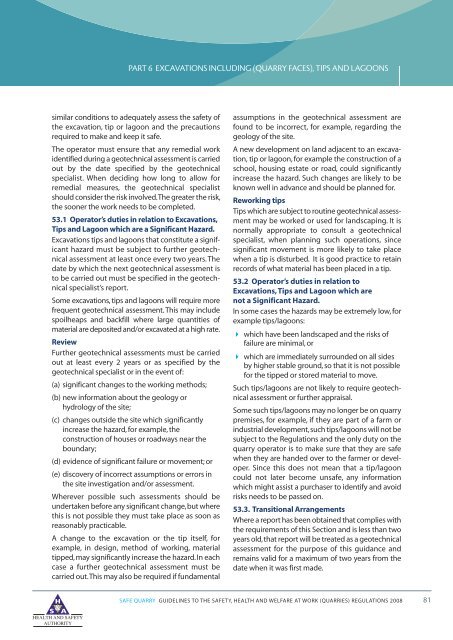Safe Quarry - Health and Safety Authority
Safe Quarry - Health and Safety Authority
Safe Quarry - Health and Safety Authority
You also want an ePaper? Increase the reach of your titles
YUMPU automatically turns print PDFs into web optimized ePapers that Google loves.
PART 6 EXCAVATIONS INCLUDING (QUARRY FACES), TIPS AND LAGOONS<br />
similar conditions to adequately assess the safety of<br />
the excavation, tip or lagoon <strong>and</strong> the precautions<br />
required to make <strong>and</strong> keep it safe.<br />
The operator must ensure that any remedial work<br />
identified during a geotechnical assessment is carried<br />
out by the date specified by the geotechnical<br />
specialist. When deciding how long to allow for<br />
remedial measures, the geotechnical specialist<br />
should consider the risk involved.The greater the risk,<br />
the sooner the work needs to be completed.<br />
53.1 Operator’s duties in relation to Excavations,<br />
Tips <strong>and</strong> Lagoon which are a Significant Hazard.<br />
Excavations tips <strong>and</strong> lagoons that constitute a significant<br />
hazard must be subject to further geotechnical<br />
assessment at least once every two years. The<br />
date by which the next geotechnical assessment is<br />
to be carried out must be specified in the geotechnical<br />
specialist’s report.<br />
Some excavations, tips <strong>and</strong> lagoons will require more<br />
frequent geotechnical assessment. This may include<br />
spoilheaps <strong>and</strong> backfill where large quantities of<br />
material are deposited <strong>and</strong>/or excavated at a high rate.<br />
Review<br />
Further geotechnical assessments must be carried<br />
out at least every 2 years or as specified by the<br />
geotechnical specialist or in the event of:<br />
(a) significant changes to the working methods;<br />
(b) new information about the geology or<br />
hydrology of the site;<br />
(c) changes outside the site which significantly<br />
increase the hazard, for example, the<br />
construction of houses or roadways near the<br />
boundary;<br />
(d) evidence of significant failure or movement; or<br />
(e) discovery of incorrect assumptions or errors in<br />
the site investigation <strong>and</strong>/or assessment.<br />
Wherever possible such assessments should be<br />
undertaken before any significant change,but where<br />
this is not possible they must take place as soon as<br />
reasonably practicable.<br />
A change to the excavation or the tip itself, for<br />
example, in design, method of working, material<br />
tipped, may significantly increase the hazard.In each<br />
case a further geotechnical assessment must be<br />
carried out.This may also be required if fundamental<br />
assumptions in the geotechnical assessment are<br />
found to be incorrect, for example, regarding the<br />
geology of the site.<br />
A new development on l<strong>and</strong> adjacent to an excavation,<br />
tip or lagoon, for example the construction of a<br />
school, housing estate or road, could significantly<br />
increase the hazard. Such changes are likely to be<br />
known well in advance <strong>and</strong> should be planned for.<br />
Reworking tips<br />
Tips which are subject to routine geotechnical assessment<br />
may be worked or used for l<strong>and</strong>scaping. It is<br />
normally appropriate to consult a geotechnical<br />
specialist, when planning such operations, since<br />
significant movement is more likely to take place<br />
when a tip is disturbed. It is good practice to retain<br />
records of what material has been placed in a tip.<br />
53.2 Operator’s duties in relation to<br />
Excavations, Tips <strong>and</strong> Lagoon which are<br />
not a Significant Hazard.<br />
In some cases the hazards may be extremely low, for<br />
example tips/lagoons:<br />
which have been l<strong>and</strong>scaped <strong>and</strong> the risks of<br />
failure are minimal, or<br />
which are immediately surrounded on all sides<br />
by higher stable ground, so that it is not possible<br />
for the tipped or stored material to move.<br />
Such tips/lagoons are not likely to require geotechnical<br />
assessment or further appraisal.<br />
Some such tips/lagoons may no longer be on quarry<br />
premises, for example, if they are part of a farm or<br />
industrial development,such tips/lagoons will not be<br />
subject to the Regulations <strong>and</strong> the only duty on the<br />
quarry operator is to make sure that they are safe<br />
when they are h<strong>and</strong>ed over to the farmer or developer.<br />
Since this does not mean that a tip/lagoon<br />
could not later become unsafe, any information<br />
which might assist a purchaser to identify <strong>and</strong> avoid<br />
risks needs to be passed on.<br />
53.3. Transitional Arrangements<br />
Where a report has been obtained that complies with<br />
the requirements of this Section <strong>and</strong> is less than two<br />
years old,that report will be treated as a geotechnical<br />
assessment for the purpose of this guidance <strong>and</strong><br />
remains valid for a maximum of two years from the<br />
date when it was first made.<br />
SAFE QUARRY GUIDELINES TO THE SAFETY, HEALTH AND WELFARE AT WORK (QUARRIES) REGULATIONS 2008 81
















